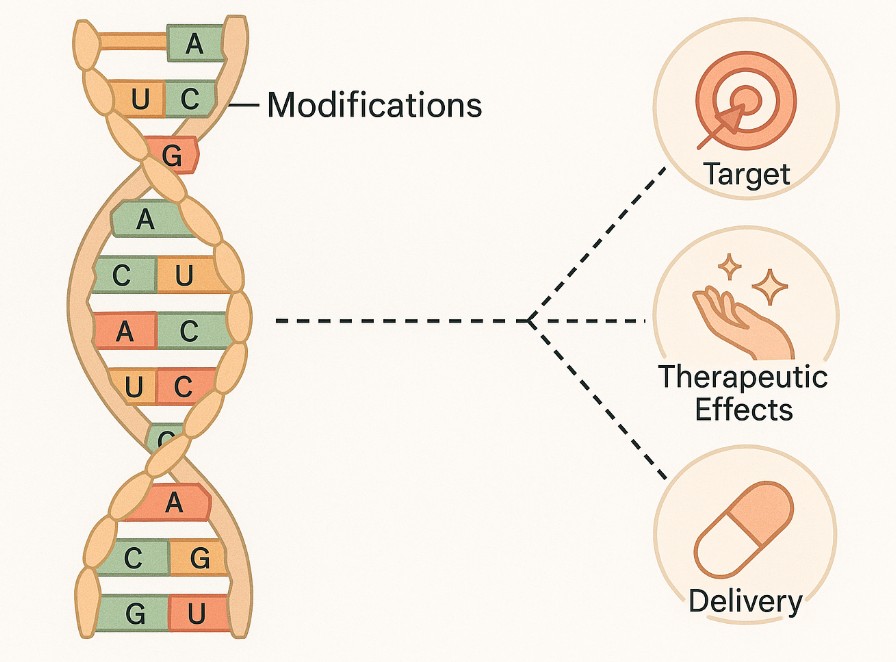Chemical modifications at the backbone, sugar, and base levels are pivotal to transforming oligonucleotides into drug-like entities. Without such enhancements, unmodified oligos suffer from poor biological stability, rapid degradation by nucleases, and limited pharmacokinetic profiles.
 Illustration showing a modified oligonucleotide strand and its key roles in drug development, including targeting, therapeutic effects, and delivery optimization. (BOC Sciences Original)
Illustration showing a modified oligonucleotide strand and its key roles in drug development, including targeting, therapeutic effects, and delivery optimization. (BOC Sciences Original)
The phosphorothioate (PS) backbone is one of the most extensively applied modifications. By replacing a non-bridging oxygen atom with sulfur in the phosphate group, PS linkages significantly enhance nuclease resistance while facilitating plasma protein binding, thereby improving half-life and systemic exposure. However, stereoisomeric complexity can influence off-target interactions and must be managed during development.
Modifications at the 2'-position of the ribose sugar, such as 2'-O-methyl (2'-OMe) and 2'-fluoro (2'-F), improve hybridization affinity to complementary RNA while providing enzymatic stability. These substitutions can modulate RNA-binding strength and reduce immune stimulation, supporting safer therapeutic profiles.
Altering the nucleobase can enhance sequence specificity or provide functional versatility. Locked Nucleic Acids (LNAs), for example, modify both the sugar and base conformation, increasing thermal stability (Tm) of duplex formation without compromising specificity.
* Related Products & Services from BOC RNA
| Products & Services | Price |
| Standard DNA Bases | Inquiry |
| Standard RNA Bases | Inquiry |
| 2'-Omethyl RNA Bases | Inquiry |
| Degenerate Bases | Inquiry |
| 2'-Modifications | Inquiry |
| Degenerate Bases | Inquiry |
| Chain Terminators | Inquiry |
The triad of efficacy, stability, and toxicity dictates the success of any oligonucleotide-based therapeutic. Chemical modifications serve as fine-tuning tools to balance these interdependent attributes:
By carefully integrating these considerations, developers can engineer oligonucleotide drugs that are not only functionally potent but also clinically translatable.
Chemical modifications are no longer optional in therapeutic oligonucleotide design—they are foundational. Each class of modification confers distinct functional advantages, whether it be enhanced target affinity, metabolic stability, or delivery capability. The strategic integration of multiple modifications often defines a candidate's clinical success potential.
The most frequently used modification in antisense oligonucleotides (ASOs), PS linkages confer nuclease resistance while allowing interaction with serum proteins. This extends plasma half-life and facilitates systemic exposure. Despite their benefits, PS linkages may increase non-specific protein binding and must be optimized to balance efficacy and tolerability. Stereopure PS oligonucleotides—where the chirality of each phosphorus center is defined—are emerging to further refine pharmacological precision.
This ribose modification enhances both nuclease resistance and RNA affinity. Often employed in the flanking wings of gapmers or in the passenger strand of siRNAs, 2'-OMe reduces immunogenicity by suppressing Toll-like receptor activation. This is particularly relevant in systemic applications where immune activation can compromise therapeutic outcomes.
2'-F modifications are common in siRNAs and short interfering oligos. They stabilize the sugar ring, increase duplex formation, and improve resistance to hydrolytic cleavage. The 2'-F group also influences helical geometry, aiding RNA-induced silencing complex (RISC) loading and activity in RNAi applications.
Together, these three modifications represent a core modification toolkit in first- and second-generation oligonucleotide therapeutics, with multiple FDA-approved drugs incorporating them in various configurations.
* Related Products & Services from BOC RNA
| Products & Services | Price |
| Phosphorylation | Inquiry |
| 2'-Modifications | Inquiry |
| 2'-Omethyl RNA Bases | Inquiry |
| 2'-Fluoro | Inquiry |
LNAs are conformationally restricted nucleotides that lock the ribose in a C3'-endo conformation. This enhances base stacking, affinity, and thermal stability. LNAs are routinely applied to increase potency and specificity, particularly in short ASOs targeting pre-mRNA splicing or microRNAs. The inclusion of LNA nucleotides can also reduce the risk of cross-reactivity in closely homologous sequences.
* Related Products & Services from BOC RNA
| Products & Services | Price |
| Custom LNA Oligonucleotide Synthesis | Inquiry |
| Custom Locked Nucleic Acid (LNA) Probe Synthesis | Inquiry |
PNAs substitute the sugar-phosphate backbone with a neutral peptide-like backbone, resulting in strong hybridization and complete nuclease resistance. Though their neutrality impairs passive uptake, PNAs are valuable in ex vivo and localized delivery contexts, and increasingly in multiplexed molecular diagnostics or gene editing applications.
* Related Products & Services from BOC RNA
| Products & Services | Price |
| Custom PNA Oligonucleotides Synthesis | Inquiry |
| Custom Peptide Nucleic Acid(PNA) Probe Synthesis | Inquiry |
Widely known from the FDA-approved drug Eteplirsen, morpholinos replace the ribose-phosphate backbone with morpholine rings and phosphorodiamidate linkages. These neutral molecules are not recognized by nucleases, making them ideal for chronic indications requiring high metabolic stability. However, their lack of charge necessitates delivery via specialized carriers such as peptide conjugates or nanoparticles.
* Related Products & Services from BOC RNA
| Products & Services | Price |
| Custom Morpholino Oligo | Inquiry |
Conjugation strategies aim to enhance delivery, cellular uptake, or tissue specificity—critical for therapeutic index optimization.
Attaching cell-penetrating peptides (CPPs) such as TAT, penetratin, or arginine-rich domains improves membrane translocation and nuclear localization. Peptide–oligonucleotide conjugates (POCs) are being intensively studied for neuromuscular and CNS-related targets.
* Related Products & Services from BOC RNA
Lipophilic modifications like cholesterol or tocopherol enable hepatocyte uptake through receptor-mediated endocytosis. This approach is exemplified by Inclisiran, a GalNAc-conjugated siRNA targeting PCSK9, which utilizes hepatocyte-specific asialoglycoprotein receptors (ASGPR) for targeted RNAi delivery.
* Related Products & Services from BOC RNA
| Products & Services | Price |
| Lipids-Oligonucleotide Conjugation | Inquiry |
| GalNAc-siRNA Conjugates | Inquiry |
| GalNAc-Oligonucleotide Conjugation | Inquiry |
AOCs represent a frontier class of therapeutics combining the specificity of monoclonal antibodies with the gene-silencing capability of oligonucleotides. By conjugating ASOs or siRNAs to antibodies via cleavable linkers, these constructs achieve tissue-specific delivery while preserving oligo bioactivity. BOC Sciences provides end-to-end services for AOC prototype development, including linker design, conjugation chemistry, and oligo characterization.
* Related Products & Services from BOC RNA
| Products & Services | Price |
| Antibody-siRNA Conjugates | Inquiry |
| Antibody-Oligonucleotide Conjugation | Inquiry |
As these modification strategies evolve, combinatorial approaches—such as LNA-enhanced, peptide-conjugated, PS-modified oligonucleotides—are becoming the norm. BOC Sciences leverages a comprehensive portfolio of these chemistries to support next-generation therapeutic programs across a wide range of indications.
BOC Sciences offers a robust and versatile platform for the synthesis of chemically modified oligonucleotides tailored to specific therapeutic and research applications. Our portfolio encompasses a full spectrum of structural and functional modifications:
Our chemists provide in-depth design consultation to recommend optimal modification combinations based on sequence context, target tissue, and intended mechanism of action (e.g., RNase H-mediated cleavage vs. steric blocking).
* Related Products & Services from BOC RNA
From microgram to multi-gram synthesis scales, BOC Sciences maintains full process control with stringent QC systems to ensure batch consistency, purity, and performance:
(1) Identity Confirmation: UPLC, MALDI-TOF MS, and ESI-MS
(2) Purity and Impurity Profiling: HPLC (A260, A280), capillary electrophoresis
(3) Structural Integrity: Duplex formation and Tm analysis
(4) Stability Testing: Serum stability assays, forced degradation studies
(5) Endotoxin and Residual Solvent Testing: In compliance with ICH Q3C and Q3D guidelines
Each oligonucleotide is delivered with a complete Certificate of Analysis (CoA) and is subjected to customizable documentation packages, including raw data files, formulation protocols, and extended stability reports upon request.
* Related Products & Services from BOC RNA
BOC Sciences functions as a critical partner to biotech and pharma clients across all stages of the preclinical pipeline—from early discovery to IND submission. Our support services are engineered to reduce development time and de-risk regulatory submissions:
Exploratory Research
Lead Optimization
Preclinical Development (IND-Enabling)
All processes are conducted in ISO-certified facilities with rigorous documentation practices to support smooth tech transfer and pre-IND communications. With our deep expertise in nucleic acid chemistry and platform flexibility, BOC Sciences is uniquely positioned to advance your oligonucleotide drug from bench to regulated studies with precision and speed.
Related Resources
New Research on RNA Methylation Modifications (m6A)
Modified Nucleotides in mRNA Therapeutics: Types and Applications
Backbone modifications like phosphorothioate increase resistance to nucleases and enhance interaction with serum proteins, extending circulation half-life and overall stability.
2'-O-methyl and 2'-fluoro modifications enhance hybridization affinity, reduce enzymatic degradation, and improve structural stability for reliable in vitro and in vivo applications.
Altered nucleobases, including LNAs and pseudouridine, increase duplex thermal stability and binding precision, allowing for shorter, more potent sequences without compromising activity.
Conjugation enhances cellular uptake, tissue targeting, and bioavailability, enabling precise delivery to desired cells or compartments while preserving oligonucleotide functionality.
Integrating multiple modifications—backbone, sugar, base, and conjugates—balances stability, affinity, and specificity, providing tailored solutions for diverse research and delivery challenges.

